The Bottom Line
Introduction & Specification Details and Close-up
Today we will be jumping into looking at the ASUS Fusion STRIX 500, the second gaming headset in the Fusion stack, right in between the Fusion 300 and the Fusion 700.
So how does ASUS's Fusion line up of headsets differentiate themselves from one another? Well, in comparison to the Fusion 300, the Fusion 500 has dropped the 3.5mm connector, has RGB instead of an LED, has a digital boom microphone instead of an analog microphone, and has RGB Bluetooth connectivity. The Fusion 500 comes in at a price of $180 and packs some of the most interesting features I've seen on a headset.
In this review, I will be running you through the normal testing routine I take when reviewing a headset. We will be looking at the design of the Fusion 500, and examining all of the features that make up that $180 price tag. Before getting into the review, I will say that the Fusion 500 isn't wireless, so if you came here thinking that this headset is wireless, it isn't. The only thing Bluetooth about it is the RGB. Now that's out of the way, let's jump right into the close up of the Fusion 500.
Close-up
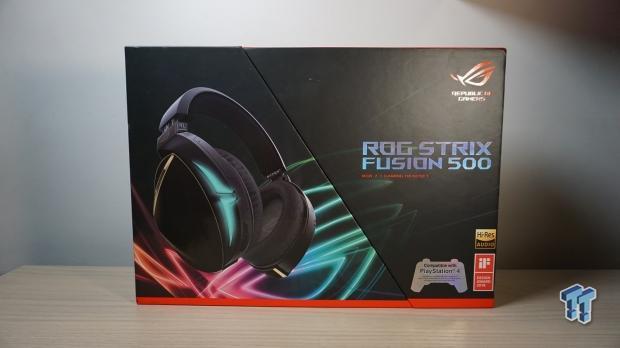
First, we have an image of the front of the box, and here we can see an image of the Fusion 500 as well as some of the features that it supports. You can see that the Fusion 500 comes with Hi-Red Audio support, 7.1 Surround Sound as well as compatibility with the PlayStation 4.
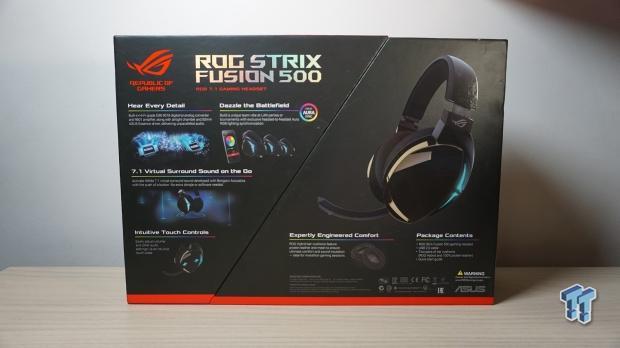
Moving onto the back of the box, we can see some more depth explanations of the Fusion 500's features. We can see explanations for the 7.1 surround sound, RGB's, touch controls, earcups, package contents, and the ASUS Essence Driver.
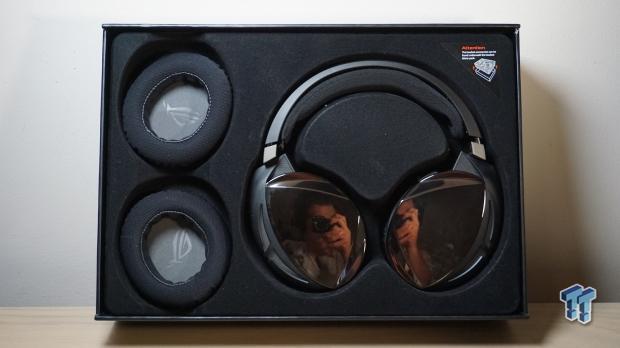
From this image, you can immediately notice that the Fusion 500 sports a reflective plastic on both earcups and that it comes with two pairs of earcups. One attached to the headset and others spare if you don't like the default ones.
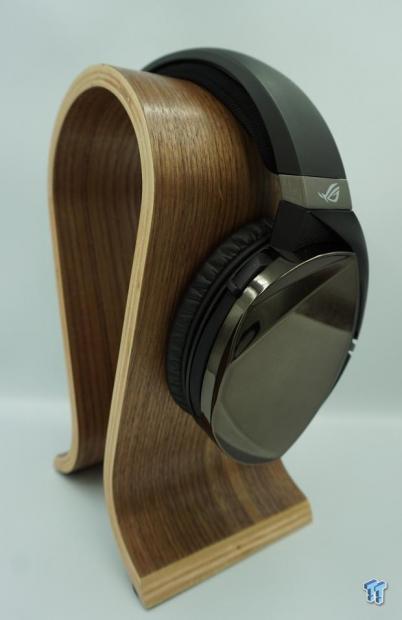
This is what the Fusion 500 looks like outside of the box. Here you can see that reflective plastic I was talking about earlier, as well as the microphone, tucked away nicely.
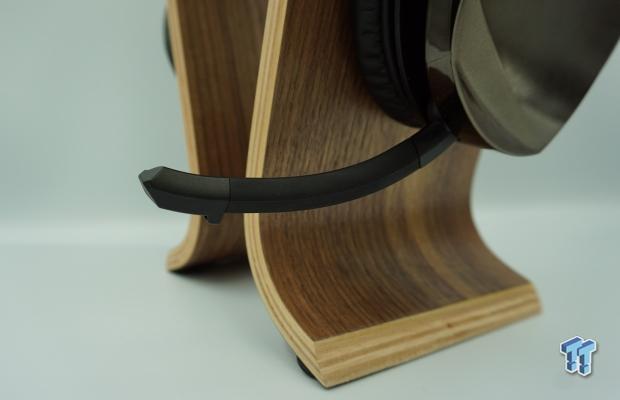
Here we can see the microphone removed from its hiding place - its middle section is made out of rubber and can be slightly adjusted to certain angles.
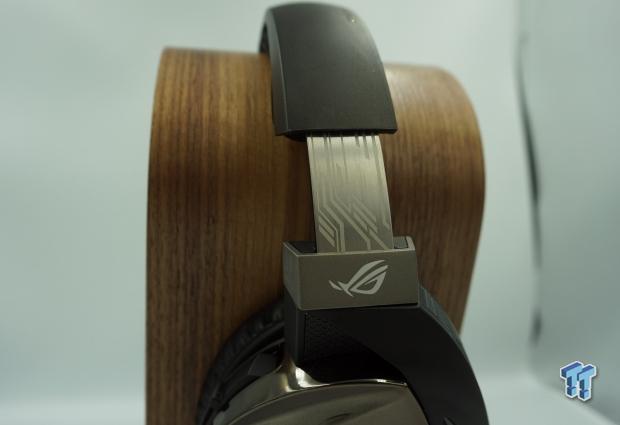
Moving onto the side of the Fusion 500's, here we can see the headsets height adjustment and that it's made out of plastic but has been reinforced with steel to give it some extra durability.
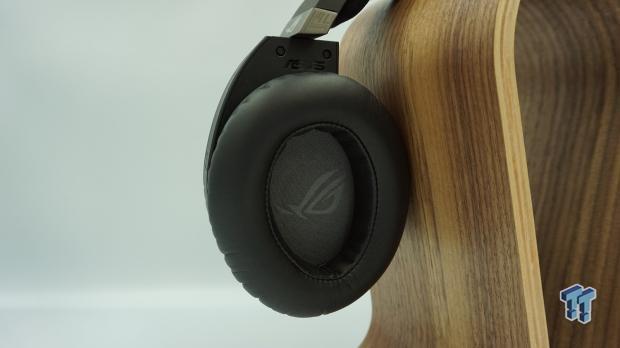
In this image, we are looking at then stock earcup. These are the leather earcups that come with the Fusion 500, and we can see that they are in an oval shape and go over the ear.
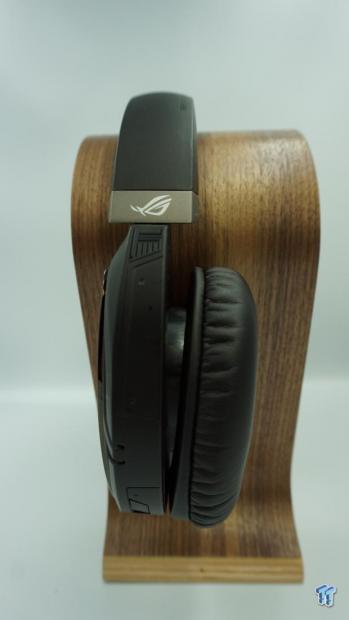
In this side-on shot of the Fusion 500, we can notice that the earcups can be rotated to sit flat on the users' shoulders. This feature also enables the headset to fit comfortably on the users' head as the rotatable earcups enable the headset to mold to whatever shape of head.
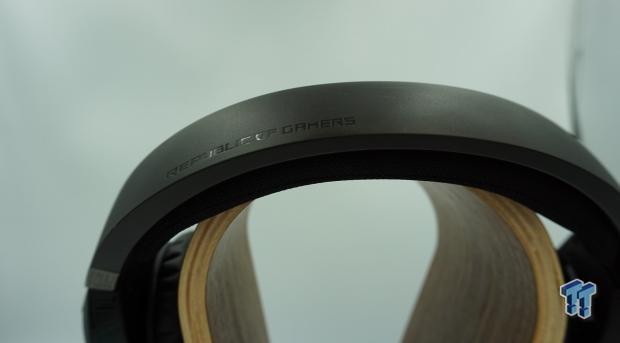
Next, we have an image of the top of the headband. Here we can see that ASUS has engraved 'Republic of Gamers' into the headband and that the headband itself is plastic. While you might not be able to see this in the provided image, the cushioning on the inside of the headband is not leather, and the cushioning itself isn't glued to the headband.

Lastly, we are having a look at the back of the left earcup. While you might not be able to see it straight away, there is a button located on the bottom half of the earcup that enables/disables the surround sound feature. I will get more into this in the performance side of the review.
Jak's Test System Specifications
- Motherboard: ASUS ROG Crosshair VIII Hero X570 (Wi-Fi) (buy from Amazon)
- CPU: AMD Ryzen 5 3600X @ 4.4GHz (buy from Amazon)
- GPU: EVGA GeForce RTX 2070 SUPER XC GAMING (buy from Amazon)
- Cooler: be quiet! Silent Wings 3
- RAM: 16GB (2x8GB) Corsair Vengeance LPX 16GB 3200MHz (buy from Amazon)
- SSD: GALAX HOF Pro SSD PCI-E M.2 2TB
- Power Supply: Corsair CX Series 750 Watt (buy from Amazon)
- Case: be quiet! Silent Base 600 (buy from Amazon)
- OS: Microsoft Windows 10 Pro 64-bit (buy from Amazon)

| Today | 7 days ago | 30 days ago | ||
|---|---|---|---|---|
| Loading... | Loading... | |||
|
* Prices last scanned on 10/26/2024 at 9:32 am CDT - prices may not be accurate, click links above for the latest price. We may earn an affiliate commission from any sales.
|
||||
Design & Software
Design
The Fusion 500 comes in at the cost of $180, which is quite expensive for a gaming headset. ASUS has spared no cost in making the user pay for the plethora of features the Fusion 500 comes with, but is it worth it? Firstly, the build quality of the Fusion 500 is great, the plastic feels tough, and the frame of the headset is reinforced with some steel - adding to the overall durability.
The headset is rather on the bulky side, though, as the earcups protrude outwards, making users' heads appear more round. Moving onto the earcups. ASUS has opted for that shiny reflective plastic that you saw in the above image. I hate this design choice purely because every single fingerprint is picked up by the plastic. Another thing that I noticed was that this headset was not on the lighter side, coming in a weight of 360g users will definitely notice the heaviness of the headset after long periods of wear time.
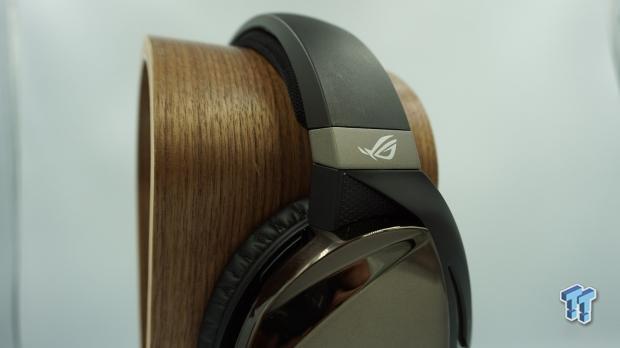
The Fusion 500 earcups can rotate 90 degrees and rest on your chest, but unfortunately, I felt as if the clamping was far too intense. This resulted in me feeling like I was being choked by the headset when I placed it around my neck. ASUS has also decided to add "intuitive touch controls" to the side of the earcups, which has no doubt added to its overall weight/cost. I like that ASUS has decided to step out of the box of traditional gaming headsets by adding touch controls, but in practice, the feature is more than annoying.
When picking up and taking off the Fusion 500, I would accidentally touch the center of the left earcup causing music to play when I didn't want it to. The exact same thing happened when I was adjusting the headset while it was on my head, and then mid-game BAM music starts playing.
This feature is incredibly annoying and overly sensitive. On top of this, the Fusion 500 is a wired headset, which makes me feel like the multimedia touch controls are a complete waste as most users will opt for using their keyboard that most likely has multimedia controls on it, or manually changing song/volume through their media player. Touch controls on a wired headset, in my opinion, are a complete waste and ended up being a feature that made the headset worse than what it actually is. Another issue is when the user is swiping up and down to change the volume that there's a delay between the volume being changed and the initial swipe. On top of that, the volume is changed in increments of four, which makes it really hard to set your volume level accurately.
ASUS has also dropped the 3.5mm jack that is present on its lower-end Fusion headset, the Fusion 300. Instead of including a 3.5mm jack, ASUS decided to add RGB lighting to the back of each earcup, which is by far the worst spot on a headset to add RGB lighting to. Why? Well, because who can see the lighting? The user can't because they are wearing the headset, and if the user is streaming, the viewers can't see it because it's on the back of the headset. ASUS also claims that the Fusion 500 is PS4 compatible, but since there is no 3.5mm jack present, PS4 gamers cannot plug this headset into their PS4 controller and are forced into plugging it into the console.
Plugging the headset into the console does give support for 7.1 surround sound, but will hinder how far back users can sit from the console. The cable is only two meters, which could rule out this headset as a purchasable option for a lot of PS4 gamers that sit more than two meters away from their console.
All in all, the design for this headset is extremely distasteful, in my opinion, and there isn't that much I can compliment about it.
Software
ASUS's software is called ROG ARMORY, and if you haven't already downloaded it, you can find a download link here.

In the above image, we are looking at the first screen you will see once you open ROG ARMORY, and as you can see, you are presented with a whole range of options. Running through these settings really quickly, we can see that users can use the equalizer, bass boost, compressor, voice clarity, perfect voice, and noise gate for the microphone. There is also the 'sound optimization' tab that allows users to cycle through presets for the headset. I suggest going through these settings and optimizing the headset for whatever suits you best. Everyone's settings will be different, as everyone interprets sound differently.

Here we are in the lighting tab, and as you can see, this is where you can change the color of the LED's that are on the back of the headset. There are preset color modes as well, such as color cycle, static, off, breathing, and music. Users can also create their own color profiles and save their settings to these profiles.
Overall, ASUS's software is very straight forward, and I believe even someone who has no knowledge of how these settings work will have no trouble navigating and understanding the software. Contrary to that statement, the settings are quite basic, so someone who is an audiophile and is looking to tweak their audio experience even further will feel encumbered by these settings. All in all, great work here ASUS.
Performance & Microphone
Performance
As with all my headset reviews, I use the headset I'm testing from anywhere between 30 and 50 hours. Throughout this time, I run the headset through numerous different testing scenarios to attempt to gather an unbiased and honest opinion about its performance. For this headset, in particular, I played lots of hours of Apex Legends, I also listened to many hours of music, and sat through a couple of movies.
Gaming Audio
The first game I played was Apex Legends was with the headset in stereo mode, and my initial thoughts when jumping straight into a game weren't the greatest. I wasn't impressed with the sound I was hearing; everything sounded hollowed out and far away. It also sounded as if the headset was in surround sound mode, but it wasn't? The lows sound fantastic, grenades have a beautiful deep ring to them, and sniper rifles had a nice deep crack every time I fired one. I do believe the trebles are overdrawn in the Fusion 500, which makes the sound experience somewhat metallic, or tin-like.
When enabling the 7.1 surround sound via the button the headset, these problems were somewhat resolved, but not fixed entirely. Everything did sound much better, the bass was a lot more tighter, the highs sounded more clean-cut, and the mids were much more forward in there presence and not as drowned out as they were without the surround sound enabled. Don't get me wrong here, the Fusion 500 by no means sounds bad, the drivers in the headset are absolutely fantastic, and the Fusion 500 has some of the best bass I've ever heard in a headset. I just believe the optimization of the highs, lows, and mids were slightly off.
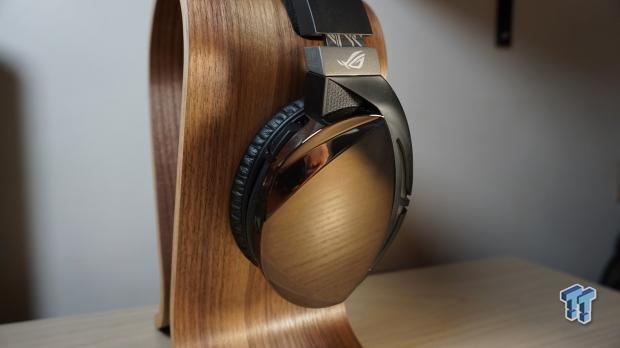
Music/Movie Listening
As for music listening, the Fusion 500 sounded far better than the average gaming headset, and I would attribute this to the ESS ES9018 DAC, and ASUS' Essence drivers. Hip-hop music that would normally not have any bass in a gaming headset sounded punchy and deep. I really loved the bass quality when listening to hip-hop, but unfortunately, I had to turn it down slightly in the software as it was drowning out some of the lyrics from the artist. As for the mid to high range, both sounded great - I have next to no complaints here.
Microphone
The microphone that comes with the Fusion 500 is simply decent -nothing more, nothing less. The microphone isn't removable, but does come with a feature that I feel is an absolute necessity for gaming headsets in 2020 - the microphone automatically muting when it's raised past the halfway point. As for the quality of the microphone, my voice didn't pack much bass, which made it sound somewhat hollow or shallow. This was to be expected, as most gaming headset microphones aren't that fantastic. The Fusion 500 is a passable microphone quality-wise but unfortunately doesn't come with a noise gate, so every keystroke that is made will be heard by whoever you are speaking to.
Final Thoughts
What's Hot
The Fusion 500 has awesome bass, and some of the best audio I've heard when it comes to music listening in a gaming headset. In-game directional audio was on point as well. Despite the hollowness of the sound, ASUS has done a great job at sound placement in games.
What's Not
The Fusion 500 has numerous design flaws, and one of them is the touch controls. These bothered me quite a lot, and overall I found them to be a useless feature. The weight of the headset is another issue, as, after long periods of use, they felt somewhat burdensome. The lack of a 3.5mm headphone jack and a not very long cable makes it hard for me to recommend this headset to PS4 gamers due to the distance issue mentioned in the design section of this review. The audio quality sounded somewhat hollowed out, and the microphone also doesn't have a noise gate.
In some areas, the Fusion 500 is a great headset, and in some other areas, it's really not that great at all, which makes it very hard for me to recommend this headset to almost any audience.
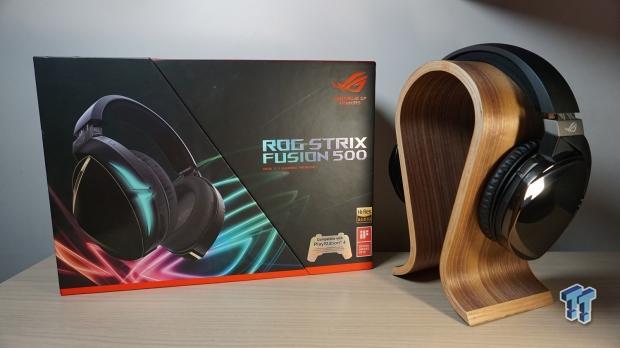
I believe ASUS attempted to jam pack this headset with too many over the top features, and throughout that, they left behind some core features that gamers love in their headsets. These things would be a volume control wheel either located on the left earcup or on the cord. Another would be a lightweight design, and a 3.5mm jack that could double for PS4/on the go music listening. These are just some features off the top of my head, and unfortunately, the Fusion 500 doesn't come with any of them.
I think ASUS went too far with the design of the Fusion 500, and in my opinion, due to all of its flaws, I don't believe it's worth the $180 price tag. If ASUS went back to the drawing board and fixed some of the issues I mentioned earlier, then I would consider recommending this headset to gamers, but unfortunately, I cannot do that at this time. ASUS has some work to do with the Fusion 500, and I'm more than sure that they have already heard the feedback and are implementing it into their next exciting design.

